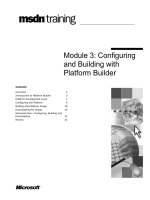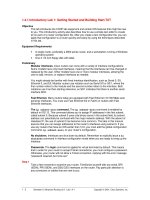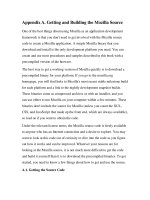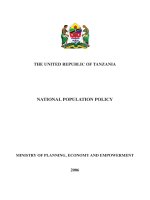Planning permission and building regulations
Bạn đang xem bản rút gọn của tài liệu. Xem và tải ngay bản đầy đủ của tài liệu tại đây (71.18 KB, 8 trang )
Planning Permission and Building Regulations.
NOTE: These notes are specific to England and Wales only. However they do not apply to
properties in Conservation Areas, Listed Buildings or Conservation Areas, Listed Buildings, or
properties other than single dwellings (such as flats) within England and Wales.
Please use the information on this page as guidance only, your local Building Control Office
will generally be please to give you detailed guidance.
Planning Permission and Building Regulation are often confused and misunderstood. Both
are the responsibility of the Local Authority and basically while Planning Permission is
permission to erect/extend a building, Building Regulations define how the new building must
be constructed.
In addition to the need for these approvals, the deeds of some properties include covenants
which defines what can be erected or requires the owner to get separate approval for
changes from previous owners of the land, ground landlords or other bodies. These approvals
are not covered in the following notes so check your deeds or obtain specific advice if you are
not sure.
Planning Permission.
Local Authorities are concerned with the visual aspect of any development, and how
appropriate is its intended use. Any person can make the planning application even if they do
not own the land or have any interest in the land. A notice of the application will be published
in the local Press and notices displayed at the property. Neighbours and anybody with an
opinion are able to view the plans and make comments which the Local Authority will have to
take into account.
The Local Authority will have a written policy which contains guidelines for what sort of
buildings may be built in any area and, possibly, also define the building style. Whether an
application is approved or refused will depend largely on the local guidelines.
The Authority's Highway Department will become involved where the application requires
vehicle access or increased road traffic.
It is general government policy that development is permitted unless there are good reasons
to refuse Planning Permission. Planning Permission is officially granted by a Planning
Committee, (elected members of the council), which is normally open to the public. However;
the Council Officers (non-elected, paid employees of the Council) will make recommendations
to the committee; if the matter is routine, the committee will normally accept the official's
recommendations. It is always worth consulting the officials before an application is made and
again before the application goes to the committee; it is then often possible to make small last
minute changes to the plans so that they will be accepted.
Even if permission is refused, there is a right of appeal - first to the council, and then to the
Secretary of State. While probably not worth while for a small application, big developers
have an army of specialists they call upon so that they finally get their wishes, even if they
have to make some modifications.
Where Planning Permission is given for a new building or alteration, Building Regulation
approval is normally also required.
Building Regulations.
These define how a new building or alteration is to be built so that the building is structurally
safe, protected from risk of fire, energy efficient and has adequate ventilation for its purpose.
An application for Building Regulations approval is not advertised and only the person
applying and the Local Authority are involved.
Building Regulations approval may be required even if Planning Permission is not.
Building Regulations approval is granted by the building control officers of local authorities,
they are generally separate from the planning officials. Once approval has been given and
work started, the local building Inspector will attend the site at specific stages to inspect the
work, and they may change the requirements as the work progresses. The most common
change is probably at the foundation stage when the Inspector will see the subsoil before the
concrete is poured. If the inspector deems that the planned depth is insufficient, they can
demand that the foundations be deepened before the concrete is laid (and you have to pay
for the extra concrete).
General.
Applications for either approval involves a fee, normally related in some way to the value of
the development.
Where the development is more than just a simple extension, it is worth considering
employing an architect to draw up the plans, submit them to the Local Authority, obtain the
approval and then to oversee the work. A professional architect will have professional
insurance in case anything should go wrong and should know the Local Officials and their
particular foibles.
Every application for Planning Permission or Building Regulations is, to an extent, unique.
While the following are general rules, it is impossible to define all the regulations applying to a
specific development - Local Authorities have some thick books of rules rather than just these
few pages. It is always good advice to consult your local planning/building control officers
early to avoid any costly abortive work. If work is carried out without the necessary approvals,
the local authority can issue an enforcement notice requiring (at best) retrospective approval
or (at worst) demolition of the work completed.
Although the functions of Planning Officials and Building Inspector are separate, the two will
often be found in the same building; they are normally very helpful and offer authoritative
guidance.
For the following the following definitions apply:
• Highway - all pubic roads, footpaths and bridleways.
• Original building - the building as it was first built
Electrics
With effect from 1st January 2005, Part P (Electrical safety) of the Building Regulations will
come into force, these mean that only very limited work can be carried out by non-certified
people without notification to the local Building Control authority.
Work which can be carried out by a non-certified individual without notification consists of:
• Replacement of fittings such as sockets, switches and light fittings.
• Replacement of the cable for a single circuit where it has been damaged.
• Work that is not in the bathroom or kitchen and consists of:
o Adding additional lighting, light fittings and switches, to an existing circuit.
o Adding additional sockets and fused spurs to an existing ring or radial main.
o Installing additional earth bonding.
All this is conditional upon the use of suitable cable and fittings for the application, that the
circuit protective measures are unaffected and suitable for protecting the new circuit, and that
all work complies with all other appropriate regulations.
All other work must either be carried out by certified individuals/companies or notified to the
local Building Control before work begins, this includes:
• All new or modifications to the electrical wiring within bathrooms or shower rooms.
• Installation or modification of electric underfloor or ceiling heating.
• Garden lighting or power installation.
• Other specialist electrical installation, examples being, Photovoltaic Solar and micro
CHP power systems.
If in doubt, check with the local Building Control.
These rules do apply to DIY activities, anyone carrying out DIY changes which are notifiable
will have to submit a building notice to the local authority before starting work and pay the fee
to have the work inspected and tested.
In future, problems may be encountered when trying to sell a property which has had
notifiable electrical work carried out but for which the appropriate certificate cannot be
produced.
Extensions
With the exception of Listed Buildings, properties in Conservation Areas, or properties other
than single dwellings (such as flats) (
see below for these types of property), extensions are
permitted without Planning Permission provided that all the following apply:
• The area of the land covered with buildings will be less than half the area of the plot.
• The new building is at least 20m from any highway or no nearer to any highway than
the original building.
• No part of the extension is higher than 4 metres and will not project above any part of
the original building (normally the roof) and will not be within 2 metres of a boundary.
• For a terraced house, the volume of the extension is less than 50m3 or 10 per cent of
the volume of the original building, whichever is the greater; with an absolute
maximum of 115m3.
• For a semi-detached or detached house the volume of the extension is less than
70m3 or 15 per cent of the volume of the original building whichever is the greater
subject - with an absolute limit of 115m3.
Note, the percentages are of the original building, this is not necessarily the same as the
current building as extensions may already have been added.
All extensions of habitable rooms require Building Regulations approval to ensure that the
building is structurally safe. In practice, this means:
• That any new or existing foundations are adequate for the extension.
• That drains and rainwater are handled in a safe manner.
• That stairs, balconies etc. meet the safety requirements.
• That the regulations covering ventilation, thermal insulation and fire safety are met.
• That suitable smoke detectors are installed - this should not impact upon extensions
unless an escape route is lengthened.
Listed Buildings, properities in Conservation Areas and properties other than single dwellings
(such as flats), have special planning requirements, so any proposed changes should be
discussed with the local Planning Authority as early as possible to ensure that any
complications can be caught as early as possible.
Change of use
Every existing building has a defined use, i.e. as a house, a number of flats, shop, office or
factory etc. Planning Permission is required if it is intended to change from one use to another
or to sub-divide the building. Planning Permission will also be required if a habitable room is
to be added into the building without extending the building (such as changing a garage into
another room).
Building Regulations Approval are also required to ensure that the regulations applicable to
the new use are met. If you convert a conservatory (see definition below) to an extension,
building regulation approval will be required.
Garages & car ports
A garage is considered to be an extension if the garage is located within 5m of the original
building, so the same rules for planning permission apply. Where the garage is positioned
more than 5m from the existing house, a garage is considered to be as a shed (see
sheds).
If a garage adjoins the house, Building Regulations approval is required.
A detached garage is exempt from Building Regulations provided:
• The floor area is less than 30 sq metres.
• It is more than 1m from a boundary, or it is a single storey and constructed of wholly
non-combustible material.
• It contains no sleeping accommodation.
Building Regulations do not apply to a carport provided the carport is open on at least two
sides AND the floor area does not exceed 30 square metres. .
Loft Conversions
Planning Permission requirements for a loft conversion are subject to the same limits on
volume, etc., as an extension. However, only the additional volumes to the existing loft will
count towards your quota. In most cases, this will be a fairly small amount even if new dormer
windows are installed, and none at all if roof lights are used.
The same height/roof line rules apply to the maximum permitted height of any dormers.
Building regulations are required; the structural requirements for any extension will apply. The
biggest problems are likely to be the headroom and size of floor joists in the existing loft.
Additional regulations cover:
• Normal access via internal stairways will need to conform. These rules are quite
involved, but the main ones define the minimum width, slope and headroom of the
stairway.
• If a loft conversion forms a third or higher floor, there must be an adequate means of
escape in case of fire. This can be achieved by providing:
A safe internal route by enclosing the stairway and any landing in material with a
rated fire resistance of 30 minutes, or a rated fire resistance of one hour for
basements, fourth or higher floors, and flats,
or
An independent route to safety (i.e. windows with ladders). In this case, the size and
access through the windows will be defined.
Aerials & Satellite Dishes
Standard domestic television and radio aerials do not require Planning Permission - it is
required for larger antennae such as for short-wave transmissions.
A satellite dish is permitted without Planning Permission provided:
• It is not greater than 900 mm in diameter.
• It does not project above the highest point of the roof.
Building Regulations approval is not required.
Swimming Pools
A swimming pool is generally exempt from Planning Permission, unless you live within a
conservation zone.
Building Regulations do not apply.
The local Water Supply Company must be notified, and water rates will usually rise.
Conservatories
First of all, what is classed as a conservatory? One definition is 'A building that is attached to
a building and which has more than 75 per cent of the roof and more than 50 per cent of the
wall areas as translucent material'.
A conservatory does not need planning permission subject to the same limits on volume,
height, etc. as for an extension.
A conservatory is not classed as a 'habitable room' so Building Regulations do not apply
provided the floor area does not exceed 30 sq m. However, you may have problems later if
you try to convert the conservatory into a habitable room if you cannot prove that the
foundations etc. were built to the required standard.
Gates, walls and fences
Gates, walls and fences do not require Planning Permission or Building Regulation approval
if:
They are no more than 2m high.
or
If they adjoin a highway, no more than 1m high.
Although Building Regulations do not apply, remember that you may be liable if members of
the public suffer damage from the structure. So the structure must be structurally sound and
maintained. Barbed wire below 2 metres is not a good idea adjacent to a highway, nor are
spikes or broken glass embedded along the top of a wall.
Hedges are not covered by planning permission.
Porches
Planning permission is not required if:
• The total floor area is not greater than 2 sq m.
• It is not more than 3m high.
• It is at least 2m from the road.
Building Regulations do not apply to a porch or covered way provided that the total floor area
is not greater than 30 sq m.
Sheds and Greenhouses
Neither Planning Permission or Building Regulation approval is required provided that:
• Sheds and greenhouses do not cover more than half of the area of the garden; not
including the area occupied by the house.
• It contains no sleeping accommodation and the floor area does not exceed 15 square
metres. .
• No point is less than one metre from a boundary.
• It is not more than 3m high for a flat roof, or 4m with a ridged roof.
• No part projects beyond any wall of the house that faces a road.
• The outbuilding is for use only by those who occupy the house.
Building Regulations do state that structures built of combustible material (i.e. a wooden
shed) must be at least 2 metres from the main house.
Building Control - New Regulations For April 2002
The amended Building Regulations 2001, together with four new Approved Documents to
Parts H, J, L1 and L2, were published in October 2001 by the UK Government. These new
provisions came into effect on 1 April 2002, for properties then under construction at that
date, there are some transitional provisions. The main effect of these amended regulations
are changes to:
• Drainage and waste disposal (Part H);
• Combustion appliances and fuel storage systems (Part J);
• Conservation of fuel and power (Parts L1 & L2).
There are other changes, including to the definitions of "controlled service or fitting" and
"building work". One result of this is that the replacement of boilers, hot storage vessels and
other building services, and provision of complete replacement windows, will be "building
work" and subject to the energy efficiency and thermal insulation requirements in the revised
Part L. With limited exceptions, all "building work" now requires approval of the local authority.
PART H (DRAINAGE AND WASTE DISPOSAL) - Some of the key changes
are:
• An expressed requirement for the provision of suitable foul and rainwater drainage is
now an express requirement.
• Sewers serving more than 10 properties must have a minimum diameter of 150 mm.
• There are new requirements and guidance for non-mains arrangements for foul water
disposal, including a prioritisation of the available options.
• There are new requirements and guidance on more sustainable forms of rainwater
drainage.
• Additional guidance is given on protection of drains and sewers from rats.
• There are new requirements and guidance about building over sewers.
PART J (COMBUSTION APPLIANCES AND FUEL STORAGE
SYSTEMS)
- Some of the changes are:
• The requirements now include measures to prevent injury from burns.
• There is a new requirement for hearths, fireplaces, flues and chimneys to have
durable labeling with safety information.
• There is new guidance on checking by competent builders of new flues, and flues
brought back into service, and there are recommendations that certificates should be
provided by competent builders and installers stating that flues and combustion
installations comply.
• There are new safety rules for the position of low level gas and oil flue outlets to
restrict discharge close to boundaries.
• There is now guidance on installing fixed flueless gas fires, including the need to
provide permanent ventilation.
• There are new requirements and guidance on the protection of oil and LPG fuel tanks
from fire, and on precautions against pollution of water by oil from domestic fuel
tanks.
PART L (CONSERVATION OF FUEL AND POWER) - In the new Part L, L1
deals with dwellings and L2 with other buildings. There are now separate approved
documents for L1 and L2. The changes for dwellings include:
The changes for buildings other than dwellings include:
• Requirements applying to the overall system performance of heating and hot water
systems.
• Systems must be inspected and commissioned by installers to check that adequate
performance has been achieved. It is recommended that certificates should be
provided by installers that commissioning has been successfully carried out.
• There are higher standards for the insulation performance (U values) of walls, floors,
roofs, windows and doors.
• There are changes to the elemental and target U value methods for showing
compliance and the introduction of a "carbon index method" to replace the energy
rating method but under separate existing provisions of the regulations, energy
ratings (SAP ratings - Standard Assessment Procedure) must still be calculated and
notices giving the ratings must be posted up in new dwellings.
• Changes to guidance on thermal bridging and airtightness, backed by guidance on
robust construction details which is to be published separately in November 2002.
• New requirement for energy efficient lighting with a new dwelling or new extension.
• New requirement for information to be provided to homeowners on how heating and
hot water systems can be operated in an energy-efficient manner.
The Association of Control Manufactuers (TACMA) have a number of guides to
Part L 2002 (Englands/Wales) on their website:
Full Industrial Guide A full guide to determine what is required to comply with
The Regulations covering both new and existing build situations. This document is
essential for all heating system specifiers, installers and designers, and Building
Control Officers.
(Size :1.92M - Acrobat Format)
Short Industrial Guide A leaflet explaining the essential requirements
particularly for existing dwellings and aimed at installers.
(Size: 1.31M - Acrobat Format)
TACMA Guide TACMA have produced a specific guidance on the control
specifications that meet the Regulations.
(Size: 1.10M - Acrobat Format)
The changes for buildings other than dwellings include:
• Changes to the elemental method for showing compliance and new whole building
and carbon emissions calculation methods.
• There are recommendations that builders should obtain certificates of compliance as
regards airtightness and insulation continuity.
• Higher standards for the insulation performance (U-values) of walls, floors, roofs
windows and doors.
• Requirements addressing the summer performance of buildings i.e. solar overheating
and heat gains through the fabric.
• Requirements applying to the overall system performance of heating and hot water
systems.
• Requirements applying to air-conditioning and mechanical ventilation.
• Changes to the requirements on lighting.
• Building services systems must be inspected and commissioned by installers, and it
is recommended that certificates should be provided by installers that commissioning
has been successfully carried out.
• New requirements for information to be provided on the maintenance and operation
of buildings and services.
Transitional provisions:
The amended regulations above came into effect on 1 April 2002. However the unamended
regulations will continue to apply for building work which was started before 1 April 2002. The
unamended regulations will also continue to apply to work started on or after 1 April 2002, if
plans of the work were fully passed by a local authority before that date.
Where work involves the construction of more than one new building, such as an estate of
houses, relevant work must have started on a particular building before 1 April 2002 in order
for that building to be exempt from the changes in the requirements.









